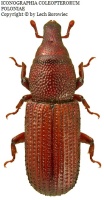Підтримуємо Вільну Україну
 We Support Free Ukraine
We Support Free Ukraine

Biodiversity Map
Taxa

Hexarthrum — subordinate taxa:
Taxon count: 1
-
Arthropodaphylum
Click to switch
to select orders
and filters > -
Hexapodasubphylum
Click to switch
to select orders
and filters > -
Insectaclass
Click to switch
to select orders
and filters > -
Coleopteraorder
Click to set
as the main taxon
and as a base
← of the left panel > -
Polyphagasuborder
Click to set
as the main taxon
and as a base
← of the left panel > -
Cucujiformiaseries
Click to set
as the main taxon
and as a base
← of the left panel > -
Curculionoideasuperfamily
Click to set
as the main taxon
and as a base
← of the left panel > -
Curculionidaefamily
Click to set
as the main taxon
and as a base
← of the left panel > -
Cossoninaesubfamily
Click to set
as the main taxon
and as a base
← of the left panel > -
Rhyncolinitribe
Click to set
as the main taxon
and as a base
← of the left panel > -
Hexarthrumgenus
Click to set
as the main taxon
and as a base
← of the left panel >
PL
YES
name status: valid name
BioMap ID: 1046199
taxon code: 5211
taxonomy checked: YES
Data on distribution in Poland

Statistics
- Records: 65
- Publications: 41
- Collections: 2
- Publication authors: 41
- Illustrations (iconography): 1
- Photos (specimen/observation): lacking
Taxon description
Gatunek rozmieszczony w południowej, środkowej i południowo-wschodniej Europie, na wschód docierający do Azji Mniejszej, Turkmenii i Afganistanu. W Polsce występuje prawdopodobnie w całym kraju, jednak z wielu krain jeszcze go nie notowano. Zasiedla lasy, parki, ogrody, stare drewniane budowle, place tartaczne, zakłady przemysłu drzewnego i górniczego. Spotykany w obumierających i martwych drzewach, w belkach, deskach podłogowych, okładzinach, podwalinach, podkładach i drewnie obudowy wyrobisk górniczych. Występuje w ciągu całego roku; przezimowuje zarówno postać dojrzała jak i larwa. Rozwój larwalny odbywa w butwiejącym drewnie drzew iglastych i liściastych; zwłaszcza atakowane jest drewno stykające się z glebą lub silnie namokłe. Dla prawidłowego przebiegu rozwoju larwalnego jest niezbędna 14-26% wilgotność drewna.
Illustrations
... browse
 Hexarthrum
Hexarthrumexiguum
External data sources
- Ostatnie rekordy
-
1099254
 ×
× Curculionidae: Hexarthrum exiguum, UA, Halicia, Podole, leg. S. Smreczyński, coll. IBL, Zakład Ochrony Lasu, Sękocin: Gottwald
Curculionidae: Hexarthrum exiguum, UA, Halicia, Podole, leg. S. Smreczyński, coll. IBL, Zakład Ochrony Lasu, Sękocin: Gottwald -
800479
 ×
× Curculionidae: Hexarthrum exiguum, PL (Kubisz et al. 1998b)
Curculionidae: Hexarthrum exiguum, PL (Kubisz et al. 1998b) -
800478
 ×
× Curculionidae: Hexarthrum exiguum, PL (Łętowski et al. 2001b)
Curculionidae: Hexarthrum exiguum, PL (Łętowski et al. 2001b) -
800477
 ×
× Curculionidae: Hexarthrum exiguum, PL (Bercio et Folwaczny 1979)
Curculionidae: Hexarthrum exiguum, PL (Bercio et Folwaczny 1979) -
800476
 ×
× Curculionidae: Hexarthrum exiguum, PL (Mazur 1994d)
Curculionidae: Hexarthrum exiguum, PL (Mazur 1994d) -
800475
 ×
× Curculionidae: Hexarthrum exiguum, PL (Knutelski et Witkowski 1995)
Curculionidae: Hexarthrum exiguum, PL (Knutelski et Witkowski 1995) -
597229
 ⊡
⊡ Curculionidae: Hexarthrum exiguum, PL, Puszcza Białowieska, podlaskie, Gnilec, UTM FD75, 1998, leg. M. Wanat (Wanat 1999)
Curculionidae: Hexarthrum exiguum, PL, Puszcza Białowieska, podlaskie, Gnilec, UTM FD75, 1998, leg. M. Wanat (Wanat 1999) -
576824
 ⊡
⊡ Curculionidae: Hexarthrum exiguum, PL, Dolny Śląsk, dolnośląskie, Wrocław, UTM XS46, 2006, leg. M. Wanat
Curculionidae: Hexarthrum exiguum, PL, Dolny Śląsk, dolnośląskie, Wrocław, UTM XS46, 2006, leg. M. Wanat -
574723
 ⊡
⊡ Curculionidae: Hexarthrum exiguum, PL, Góry Świętokrzyskie, świętokrzyskie, Bodzentyn, UTM DB94, 2008, leg. M. Wanat
Curculionidae: Hexarthrum exiguum, PL, Góry Świętokrzyskie, świętokrzyskie, Bodzentyn, UTM DB94, 2008, leg. M. Wanat -
187684
 ×
× Curculionidae: Hexarthrum exiguum, PL, «Hrabstwo Kłodzkie» (Letzner 1871c, Burakowski et al. 1993)
Curculionidae: Hexarthrum exiguum, PL, «Hrabstwo Kłodzkie» (Letzner 1871c, Burakowski et al. 1993) - ... more
- Powiązane publikacje
-
Łętowski J., Gosik R., Staniec B., Czarniawski W. 2001b. Ryjkowcowate (Curculionidea: Rhinomaceridae, Attelabidae, Apionidae, Curculionidae) wybranych zespołów roślinnych Nadwieprzańskiego Parku Krajobrazowego. Parki Nar. Rez. Przyr., 20(4):47-66.
 Show records
Show records -
Wanat M. 1999. Ryjkowce (Coleoptera: Curculionoidea bez Scolytidae i Platypodidae) Puszczy Białowieskiej – charakterystyka fauny. Parki Nar. Rez. Przyr., 11(3):25-47.
 Show records
Show records -
Kubisz D., Kuśka A., Pawłowski J.S. 1998b. Czerwona lista chrząszczy (Coleoptera) Górnego Śląska. [In:] Centrum Dziedzictwa Przyrody Górnego Śląska Raporty Opinie Tom 3. Katowice. pp. 8-68.
 Show records
Show records -
Knutelski S., Witkowski Z.J. 1995. Ryjkowce (Coleoptera: Curculionoidea) obszaru przyszłych zbiorników wodnych Czorsztyn-Niedzica i Sromowce Wyżne oraz przyległych pasm karpackich. Pieniny – Przyroda i Człowiek. Tom 4. Krościenko n/D..
 Show records
Show records -
Mazur M. 1994d. Rozmieszczenie ryjkowców (Coleoptera: Rhinomaceridae, Attelabidae, Apionidae, Curculionidae) na Pogórzu Dynowskim i Przemyskim. Zesz. Nauk. UJ, Zoologia., 40:35-76.
 Show records
Show records - ... more
- Powiązane zbiory
-
Kuśka A.*
 Show records
Show records -
Wanat M.
 Show records
Show records -
IBL, Zakład Ochrony Lasu, Sękocin: Gottwald
 Show records
Show records
- Wykaz powiązanych pozycji
-
Curculionoidea of Poland
 Show records
Show records





